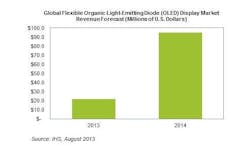Flexible OLED market to rise 334% to nearly $100M in 2014
Englewood, CO--According to market research firm IHS (NYSE: IHS), following Samsung's introduction of the first flexible organic light-emitting diode (OLED) products this year, demand for these elastic displays is expected to grow by more than a factor of four next year, with sales reaching nearly $100 million in 2014. Global market revenue for flexible OLEDs will rise to $94.8 million in 2014, up from $21.9 million in 2013, according to a new report entitled "In-depth analysis for Technical Trends of Flexible OLED" from IHS.
The projected growth next year will equate to a 334% expansion from this year, paving the way for much larger sales in the future.
The report says that OLEDs represent a major segment of the larger flexible display market, which in the coming years will also include liquid-crystal display (LCD) and electronic paper (e-paper) technology. "The buzz about flexible displays has been growing louder, ever since Samsung Display demonstrated its Youm line of bendable OLED products at the Consumer Electronics Show in January," said Vinita Jakhanwal, director of mobile and emerging displays and technology at IHS. "Samsung is expected to begin shipping its first flexible OLED display—a 5-inch screen—in the second half of this year."
Samsung's initial product is likely to be a first-generation flexible display, employing a non-glass substrate that yields superior thinness and unbreakable ruggedness. However, such displays are flat and cannot be bent or rolled. Flexible displays are expected to eventually evolve into rollable and foldable OLED screens that are likely to be introduced after 2016.
Even so, it is too early for flexible OLED panels to fully replace conventional OLED screens. This is because the plastic substrate, thin-film encapsulation and other related technologies for flexible OLED remain immature for immediate application. Moreover, manufacturing processes are still being tested.
"A wide range of complementary technologies are under development to accelerate the advancement of flexible displays," Jakhanwal said. "The success of the flexible OLED market will ultimately be determined by the maturity of the materials and manufacturing processes that will enable large-volume production at reasonable costs."

Gail Overton | Senior Editor (2004-2020)
Gail has more than 30 years of engineering, marketing, product management, and editorial experience in the photonics and optical communications industry. Before joining the staff at Laser Focus World in 2004, she held many product management and product marketing roles in the fiber-optics industry, most notably at Hughes (El Segundo, CA), GTE Labs (Waltham, MA), Corning (Corning, NY), Photon Kinetics (Beaverton, OR), and Newport Corporation (Irvine, CA). During her marketing career, Gail published articles in WDM Solutions and Sensors magazine and traveled internationally to conduct product and sales training. Gail received her BS degree in physics, with an emphasis in optics, from San Diego State University in San Diego, CA in May 1986.
